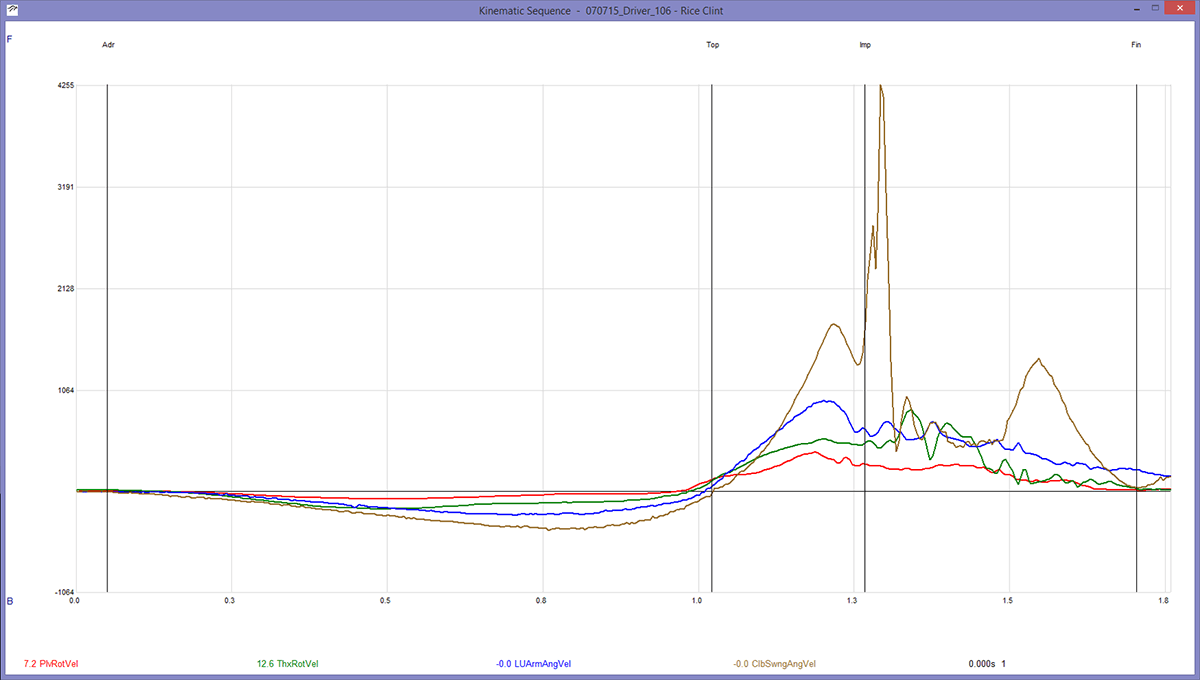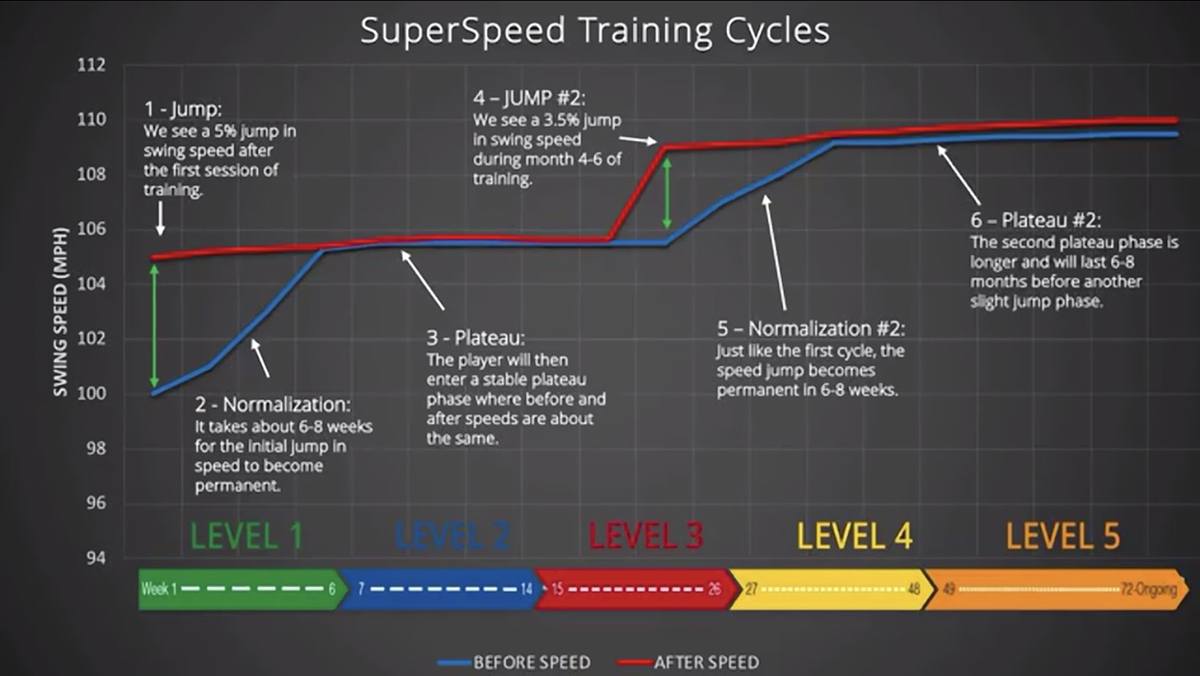The SuperSpeed Golf Training System helps players increase swing speed through a concept called OverSpeedTraining. Coined by the SuperSpeed Team in 2014, OverSpeed Training resets the normal reaction speed of a learned motor pattern to something faster. This works by first reducing the weight of the golf club, therefore allowing the player to create a faster than normal golf swing. The brain “remembers” this faster speed as the training progresses through the three training clubs, which gradually increase in weight.
For example, a player that is starting at a swing speed of 100 MPH will be able to swing the light club (green) at about 118-120 MPH on average. The player will then move to the medium club (blue). Because the player just produced the 118-120 MPH swing with the green club, the brain remembers the speed of this neuromuscular reaction. With the blue club, that same player will swing at about 115 MPH on average. Then, the player will move to the heavy club (Red), which is 5% heavier than their driver.
Because of this speed reset, the player will swing this club at about 110-112 MPH on average. That is much faster than their normal swing speed of 100 MPH. Once the player goes back to hitting balls, adding back in the skill element of the sport, they will see an increase to about 105 MPH. With continued practice, this will become a permanent increase in swing speed.
While most training aid companies talk a good game, SuperSpeed is one of the few that has been able to provide real data to show that its product works.
Case Study: Clint Rice – Australian Tour, Asian Tour
Background: Clint began working with SuperSpeed in January of 2015. He had been working with a top coach in Australia for several years with the goal of increasing swing speed. In a 3-year period, he increased clubhead speed through intense gym work and mechanical improvement from an average of 104.5 to 106. Clint was fairly happy with these results.
Swing Characteristics: Overall solid fundamental mechanics. He tended to early extend slightly during the backswing and remain stable with this motion through the downswing and impact. He tended to hinge the club fairly early in the backswing and not create much increase in lag during the transition.
Biomechanics: Clint had good overall patterning to the kinematic sequence. His peak speeds in all segments were significantly below the tour average. He had a significant amount of downswing loading between the pelvis and the torso, but very little between the Torso and distal segments. He also had a significant deceleration variant in the Torso segment and a very slow thorax rotational peak speed.
Kinematic Sequence
The Kinematic Sequence has been studied for many years as it relates to the golf swing. The graphs below show the efficiency of energy transfer between the different segments of the golf swing. Generally, it looks at the pelvis, torso, lead arm, and club as the main segments of the Kinematic Sequence. As each segment begins to fire in the downswing, we see each follow a pattern of acceleration, peak, and deceleration. How fast each segment accelerates and decelerates, has a strong correlation to how much energy will transfer to the next segment in the chain. Basically, the steeper the line goes up represents acceleration, and the steeper it goes down represents deceleration.
Kinematic Sequence – 1/2015
Notice the thorax deceleration variant and the large amount of downswing loading between the pelvis and the rest of the segments.
Kinematic Sequence – 7/2015
We retested data in July of 2015. Here are the results after working with SuperSpeed golf for six months.
We concluded from this retest data sample that Clint had improved the original deceleration variant and balanced out the segmental interaction of his sequence considerably. In fact, at this point, he was swinging the golf club around an average of 115 MPH, an increase from a 106 average in January.
Initial results with SuperSpeed Training:
Changes seen in the Trackman data after Clint’s initial assessment were significant. He started with a club speed average of 105.8 and a maximum of 106.7 before undergoing a level 1 SuperSpeed Protocol. After the 15-minute training session with SuperSpeed, we immediately hit balls again and retested Trackman data.
Here were the results:
Before:

This was a single swing from the set. This was a pretty typical swing that Clint saw in competition.
After:
This swing was the very first one out of the gate after the SuperSpeed training. We saw an initial increase for Clint of 7 MPH in swing speed and 8.5 MPH in ball speed.
OverSpeed Training works in a series of phases. These include the Jump Phase, a gradual Normalization Phase, and a Plateau Phase. The jump tends to occur after the first session of training. If a player measured their swing speed before the training and then again immediately after the session, that player would see a Jump in speed of about 5% of their starting swing speed. This change is not permanent yet. The player must then go through about 6-8 weeks of regular training. This is the Normalization Phase. During this time the player’s swing speed before the training will gradually get faster and faster as it approaches the speed after the session in the initial Jump. Once the before and after speed are the same, the player has reached the first Plateau Phase. Once a player reaches this point, the increase in swing speed is permanent. Below is a chart illustrating this pattern.
Clint’s current progress has shown continued improvement with club speed. Here is data from a recent Trackman session. This represents a little over a year of training with SuperSpeed Golf. As you can see, the club speed gains are significant. Clint has gained aproximately 13MPH since he started training with SuperSpeed.
Have You Tried SuperSpeed?
Have you tried SuperSpeed? We’d love to hear more about your experience with the system.
The SuperSpeed training system is used by more than 350 Touring Professionals worldwide. For more information on how you can increase your clubhead speed, visit SuperSpeedGolf.com.




















David Marsden
6 days ago
I’m not seeing the results. I’m 12 sessions in. My initial driver speed was 92 mph. My green speed max since is 103, blue is 98 and red is 96. All very close to my actual driver speed. What am I doing wrong. Above person with 100mph swings green at 118-120. I’m not even close to that percentage jump.